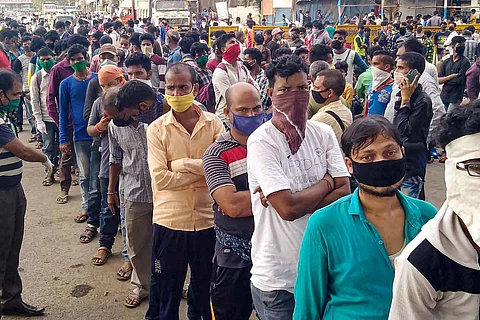

In celebrating the Kerala COVID-10 story, some are making erroneous references to the population density of the state to claim that despite the third highest population density, the state has managed to prevent community spread of the epidemic. In fact, it's not just the semi-informed, but also others who repeatedly make this point.
At 859 people per sq km, Kerala of course has the third highest average population density in India, however, what has been missed is that the state’s COVID-19 glory comes from its comparison with Maharashtra, Tamil Nadu, Delhi and Gujarat. In these states, the majority of coronavirus cases are from their main cities such as Mumbai, Chennai and Ahmedabad. Had there been no such epicentres, the overall disease-burden in these states would have been remarkably lower and they wouldn’t have looked this bad.
Now let’s compare the population densities of Kerala with the above-mentioned hotspots.
Kerala’s average population density is 859 per sq km whereas Greater Mumbai is 27,411 per sq km while Chennai is more than 25,000 per sq km. Delhi and Ahmedabad have about 11,000 and 11,895 per sq km respectively. These are massive numbers compared to even global hotspots such as New York (about 10,900 per sq km) and London (about 5700 per sq km). When the inequality in distribution of dwelling space is also taken into consideration, it’s practically impossible to contain such a viciously infectious disease in such crowded places. In fact, it’s still a miracle how cities such as Mumbai and Chennai have been able to handle the spread at such levels. Probably, it’s still only the tip of the iceberg.
This is the fallacy in using aggregate numbers for localised challenges as well as successes. Kerala’s “third highest population density” of 859 people per sq km is an aggregate number and the highest figure is in Thiruvananthapuram - 1508 per sq km. What’s more remarkable is that the places where it spread the most such as Kannur and Kasargode have less number of people than the state’s average.
Kerala has indeed tamed the epidemic so far because the gateways to the virus were clearly visible and they could be blocked early enough. It doesn’t have the same dynamic movement of people from other states similar to Mumbai, Chennai and Delhi. In other words, a comparatively very low population density, and a moderate inward movement of people are what have saved the state. Even if the other states had the same strategy of blocking inward movement of people, it wouldn’t have been as simple as in Kerala. Moreover, the housing infrastructure in Kerala is the best in India and hence home quarantine worked better. In a city such as Mumbai, where the inequality of living space available to its citizens is so high (e.g. Dharavi), a Kerala model is impossible. In fact, no model, other than trying your best, is possible in such places.
Tracing primary and secondary contacts and quarantining/isolating them was another strategy that has seemingly worked in Kerala. It’s a humongous task in populations of the size of Mumbai and Chennai. New York Governor Andrew Cuomo, made famous now by his daily Covid briefings, estimates the number of “tracers” required at 30 per 100,000 population. It’s an impossible resource for a poor country such as India.
The unnoticed mistake in celebrating the Kerala story is that it overlooks the underlying conditions and drivers of the epidemic elsewhere. As long as growth inequalities and poor development continue in most parts of India, the only few places of wealth production and livelihood generation - however meagre it is - will continue to attract people from all over the country. They crowd the tiny spaces of big cities, live in unsanitary conditions and contract and spread pathogens whenever epidemics break out. That’s what’s happening in places such Mumbai, Chennai, Ahmedabad and New Delhi. And these “floating populations” are constantly moving, not like the migrant labourers in Kerala who are more or less spread across the state and are semi-domiciled.
The point to note is that both development challenges and gains cannot be disaggregated unless there’s some semblance of even distribution. Aggregating development data for India, for instance, is the biggest folly that both the national government, the media and multilateral agencies such as the World Bank, United Nations (UN) and the International Monetary Fund (IMF) indulge in. There’s neither a single India nor a single state as a development unit. For instance, more than 60% of the COVID-19 cases in Tamil Nadu are from Chennai, but it’s aggregated and credited to the state, making the whole state look like a hotspot.
And lastly, the population density debate harks back to how Kerala has reduced its number of people over the last 100 years. From 26.33% in 1951-61, the decadal growth of the state’s population has declined to a mere 4.86% as against the country’s average of 17.64%. In fact, in 1951-61, the state’s decadal growth was higher than the national average.
In other words, the population story too should be part of Kerala’s public health legacy that has helped contain COVID-19 whether the political propagandists like it or not.
(By the way, Travancore had the third highest population density even in the 1931 Census. Despite such consistently vigorous growth in the rest of India, its present, larger state form, Kerala, still has the third highest population density. Strange, isn’ it?)
G Pramod Kumar, a former journalist and UNDP Senior Adviser in the Asia Pacific, is presently based out of Chennai and Thiruvananthapuram. Views are author's own.